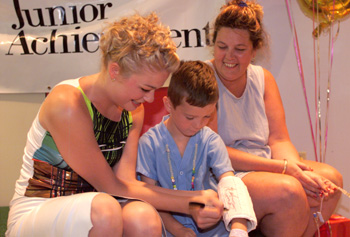
Lions Eye Center program fighting childhood blindness across the state
When Eileen Marsh picked up her three-year-old twins, Kathleen and David, last fall at their White House, Tenn. preschool, the director handed her a packet of information from a Lion's Club vision screening saying her daughter's eyesight needed further evaluation.
"I asked how many other children tested were in the same situation and she told me that Kathleen was the only one," Marsh recalls. "So I thought the screening must not be accurate. I was wrong."
Kathleen is one of 30,000 Tennessee preschool children who have been screened for vision disorders since 1997 through the Tennessee Lions Eye Center Outreach Program, part of the Tennessee Lions Eye Center at Vanderbilt Children's Hospital.
The screenings are conducted using hand-held cameras (PhotoScreeners) operated by some of the 800 trained members of the Tennessee Lions Eye Clubs. The black and white photographs are sent back to the Vanderbilt Ophthalmic Photography Reading Center at VUMC to be evaluated. There, examiners are on the lookout for a host of vision problems, including strabismus (misaligned eyes); cataracts; hyperopia (farsightedness); myopia (nearsightedness); astigmatism; and anisometropia (the difference in refractive error between the eyes).
The goal of the program is to prevent childhood blindness through early detection and treatment of the most common vision disorders that can cause amblyopia (lazy eye).
Most of the children screened are between six months and four years of age. The screenings are held at day care centers, preschools, Sunday schools and upon request at organized sites.
The Marshes were referred to Dr. Robbin B. Sinatra, assistant professor of Ophthalmology and Visual Sciences and Kathleen's vision problem was confirmed as anisometropia. Kathleen was only using her "good eye," and the "bad eye" was not being used at all, her mother said.
"As parents, we could never have detected the problem ourselves because she sees great out of the one eye she was using," Eileen wrote in a thank you letter to the White House Lions Club, the group that conducted the screening. "We realize that what you do for others comes from your hearts and we wanted to share our story with you so that you know for sure you are making a difference in the life of a child. Hopefully with the early diagnosis of Kathleen's vision problems, she will be able to see with both eyes. And for this, we will always be very thankful to you."
Kathleen is being seen every three months by Sinatra at the TLEC and her parents participate in the treatment by dilating her "good eye," forcing the weaker eye to work. By April, she had begun using the weaker eye, her mother says. Her vision in her stronger eye is 20/20.
The TLEC screening program is being used as a model for similar programs being started by Lions Clubs across the nation. Dr. Sean P. Donahue, assistant professor of Ophthalmology and Visual Sciences, said the center has received inquiries about training from Lions Clubs in 17 states and foreign countries. Orientation programs hosted for other states are being funded by a grant from the Lions Club International Foundation.
"Our program at Vanderbilt took off from just a brainstorm idea three years ago," Donahue said. "It began with two medical students doing the screenings as part of the community scholars program and it is now a program that is recognized on a worldwide basis. Thanks to the hard work of Lions Clubs and Tammy Johnson (director of outreach for TLEC), it's starting to get the recognition it deserves."
Johnson said one of the biggest advancements in the program has been the follow-up rate, originally 37 percent when the program began, and now 70 percent. That rate has improved since Becca Killebrew joined the outreach program as a follow-up coordinator. She telephones the parents of the children who are shown to need follow-up care at the screening to make sure they are being referred to an optometrist or ophthalmologist and that the results from the doctors visits are sent back to Vanderbilt and compared to the screening diagnosis.
Donahue said that the program is currently testing other types of technology that may change the way testing is done in the future.
A digital analysis program — digital camera, digital photograph and computerized analysis package — has been tested, but had some problems and is currently being refined.
Another screening technology currently being evaluated does not use a photograph but instead evaluates how well the eyes are working together. It relies on a series of dots and circles in a viewing box.
Suppression is present if a child is developing amblyopia (lazy eye). The test is best used for four and five year olds since the children must be able to understand the directions. It is being used simultaneously with the PhotoScreener in some of the screenings so the two sets of results can be compared.
"Our program is full circle from planning to screening to making sure the child sees a doctor, to making sure our diagnosis is correct," Johnson said.













